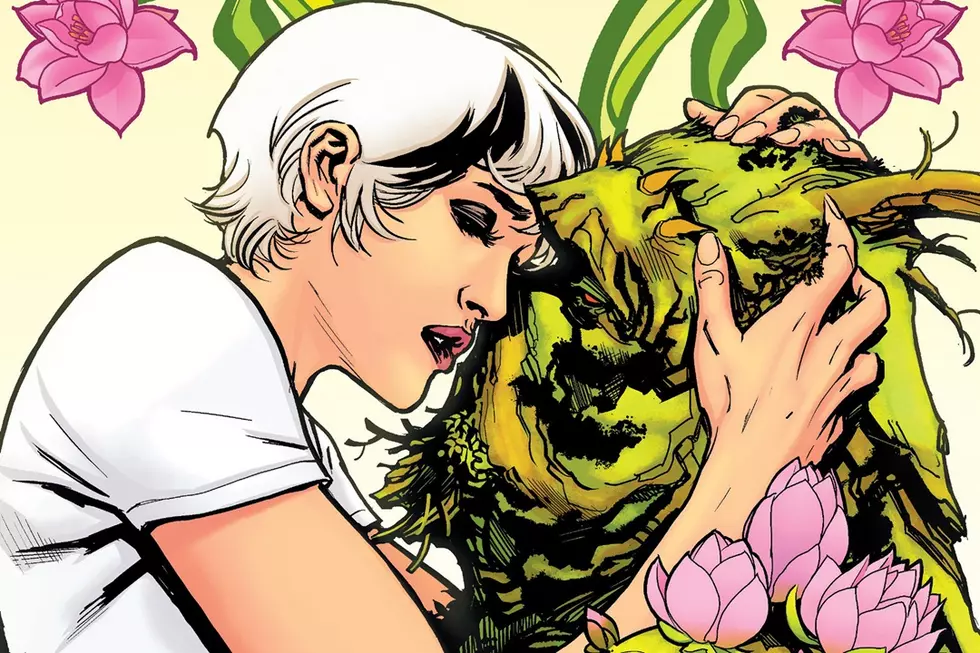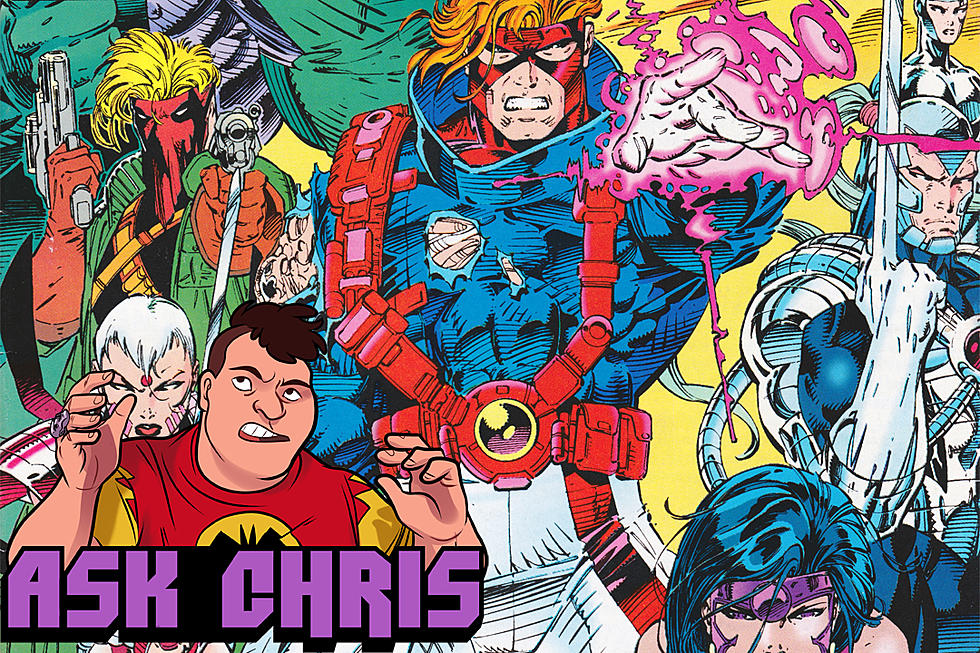
Gays In Comics: From Northstar to Shatterstar
 The most recent issue of "X-Factor" ended with two male team members, Shatterstar and Rictor, making out. While we'll have to wait till next month to find out whether they're gay, bisexual, or it's some sort of mind-control plot point, consider writer Peter David's track record of supporting gay characters in comics -- and the lesser-known fact that writers planned for the pair to hook up back in the mid-90s.There's a good shot this is the start of a whirlwind romance.
The most recent issue of "X-Factor" ended with two male team members, Shatterstar and Rictor, making out. While we'll have to wait till next month to find out whether they're gay, bisexual, or it's some sort of mind-control plot point, consider writer Peter David's track record of supporting gay characters in comics -- and the lesser-known fact that writers planned for the pair to hook up back in the mid-90s.There's a good shot this is the start of a whirlwind romance.
Yet Mainstream comics haven't always been so progressive. The Comics Code Authority was created in the 50s partly out of paranoid fears that Batman and Robin were secret gay lovers, and forbade homosexuality as a "sex perversion" until 1989.
In honor of the "X-Factor" liplock -- and recent promotion of the crime-fighting lesbian Batwoman to the helm of "Detective Comics" -- here's an overview of the most important gay characters in comics, and how attitudes in the industry have changed from censorship to celebration.
Northstar

"Alpha Flight" hero Northstar broke ground as one of the very first high profile gay superheroes in comics, although his path out of the closet was not an easy one. Writer John Byrne's original idea to make him gay was stymied by the "no gays in Marvel" comics edict of then Editor-in-Chief Jim Shooter, making his sexuality something that could only be implied, not acknowledged.
Years later, Northstar contracted an illness that was intended to be AIDS, but editors quashed the storyline and decided that instead of AIDS, it was actually a magical disease that could be healed by going back to his magic homeland. No, that isn't a joke.
In 1992, Northstar finally came out, an announcement that made mainstream news. Despite their step forward, the Marvel Comics of the day didn't seem very happy with the publicity, and as current "X-Factor" writer Peter David said at the time:
"The message being delivered to the American public was clear. Someone high up, probably very high up (certainly higher than [editor Tom] DeFalco) was extremely embarrassed by the story. Here various news agencies were ready to heap praise upon Marvel for daring storytelling, and the silence of Marvel's response was positively ringing. Not only did Marvel Corporate not seem proud of their achievement, but instead they came across as hoping that it would all die down very quickly."
Northstar's sexuality was then ignored for the rest of the series, and not addressed again directly until he joined the X-Men in the early 2000s.
Apollo & Midnighter

Like Northstar, Apollo and Midnighter weren't introduced as gay, although breadcrumbs were dropped until their relationship finally came out into the open in 2000. Both were members of the DC/Wildstorm team The Authority, and the pair didn't just become a gay couple, but a married gay couple who later adopted a child and were making out in front of readers long before Rictor and Shatterstar kicked it up a notch.
With Apollo's invulnerability, flight, and heat vision, and Midnighter's hyperviolent fighting skills, Apollo was also a clear analog for Superman, and Midnighter for Batman -- a spin on the famous DC Comics partnership that Frederic Wertham surely would have loved.
The Rawhide Kid

In 2003, Marvel decided they were going to revamp the 1950s gunslinger The Rawhide Kid by making him gay in a new series called "Rawhide Kid: Slap Leather." He became the first gay title character in a comic, but in a move that prompted criticism from gay supporters, Marvel released the comic -- which had no more violence than mainstream books, only indirect references to homosexuality, and no sex at all -- as an Adults Only MAX title, with the warning "Parental Advisory Explicit Content."
The content it referred to, of course, was gay innuendo and double entendres, like the Rawhide Kid's frighteningly explicit comment that "[the Lone Ranger's] mask and the powder blue outfit are fantastic. I can certainly see why the Indian follows him around."
Renee Montoya, a.k.a. The Question

Originally a cartoon character from "Batman: The Animated Series," Latina policewoman Renee Montoya made her way into the "Batman" comic, but didn't come into her own until 2003's "Gotham Central," a stunning, gritty police procedural comic about what it's like to be a beat cop in a city haunted by insane mass murderers and dark angels.
Unlike most other gay characters, Montoya did not come out, but was outed (and framed for murder) by Two-Face, leading her coworkers to mock her and her conservative family to disown her -- and many readers seemed to want to do the same.
As writer Greg Rucka said, "People got angry at this story. They accused me ... of all sorts of things... Most ridiculous to me was the accusation that we 'made' Montoya gay. As far as I'm concerned, we did no such thing. She was always gay. We were simply the first story to actually say so, and to say it in no uncertain terms."
Montoya left the force and later became The Question after the original hero died of cancer. She currently has a backup feature in "Detective Comics," after the adventures of her former lover Batwoman.
Hulkling & Wiccan

"Young Avengers" characters Hulking and Wiccan were not only revealed as a gay couple in 2005, they were created by openly gay comics and television writer Allan Heinberg ("The O.C.," "Grey's Anatomy"). Although Hulkling was originally pitched as a female shapeshifter who posed as a man, Heinberg later approached his editor about portraying him as a gay man instead, and in a sign of the changing times got the go ahead.
Unlike another shapeshifting Marvel character, Xavin, who often shifted into a female form for his lesbian girlfriend Karolina, Heinberg said that "it's actually meaningful to me that someone like Hulkling -- who has the ability to change shape, to hide, to appear 'normal' -- doesn't. He simply is who he is."
Although some readers complained about the relationship, many others wrote in support, including one fan who said, "Five years ago I could have been that 16-year-old 'Young Avengers' reader who says, 'Wow, these kids are my age, they're openly gay, and they're being accepted. Maybe I don't need to commit suicide.' "
Batwoman

In 2006, Batwoman underwent one of the most dramatic and controversial retcons in comics history, transforming from a hyper-feminine Silver Age character who was created expressly to reaffirm the heterosexuality of Batman -- and who constantly fantasized about being his girlfriend while fighting crime with lipstick and charm bracelets -- to the ass-kicking heroine who just took over "Detective Comics" from no less than Batman himself.
If you're not reading the new run by Greg Rucka and J.H. Williams, their first issue is still on the shelves, and it's scary beautiful -- like the lady herself.
There are plenty more examples, of course, including Pied Piper, Obsidian, Freedom Ring, Terry Berg, Ultimate Colossus, Lord Fanny, Phat and Vivisector, Maggie Sawyer, Josiah Power, those three characters from "Watchmen," and the countless others like Shatterstar and Rictor who are able to follow them now that the doors to the comic book closet have been opened.
 Vampires -- In Space! Or the Future! Or both! At io9!
Vampires -- In Space! Or the Future! Or both! At io9!
 Watch the Saturday Morning Watchmen cartoon at Gorillamask.
Watch the Saturday Morning Watchmen cartoon at Gorillamask.
 A preview of the all-new Adventure Comics at DC Comics!
A preview of the all-new Adventure Comics at DC Comics!
More From ComicsAlliance



![‘Batwoman’ #1 Delivers A Globetrotting Gay Adventure [Review]](http://townsquare.media/site/622/files/2017/03/BW_featured.jpg?w=980&q=75)


![Comics’ Sexiest Female Characters (From A Queer Perspective) [Love & Sex Week]](http://townsquare.media/site/622/files/2017/02/hg_featured.jpg?w=980&q=75)
![Fantastic Five: Best Comic Book Couples [Love & Sex Week]](http://townsquare.media/site/622/files/2017/02/couples.jpg?w=980&q=75)
![The Bats Swoop Down In ‘Mother Panic’ #3 [Exclusive Preview]](http://townsquare.media/site/622/files/2017/02/MOPA_featured1.jpg?w=980&q=75)
